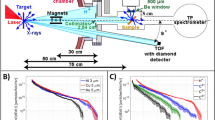Abstract
Total reflection X-ray fluorescence analysis (TXRF) offers a nondestructive qualitative and quantitative analysis of trace elements. Due to its outstanding properties TXRF is widely used in the semiconductor industry for the analysis of silicon wafer surfaces and in the chemical analysis of liquid samples. Two problems occur in quantification: the large statistical uncertainty in wafer surface analysis and the validity of using an internal standard in chemical analysis. In general TXRF is known to allow for linear calibration. For small sample amounts (low nanogram (ng) region) the thin film approximation is valid neglecting absorption effects of the exciting and the detected radiation. For higher total amounts of samples deviations from the linear relation between fluorescence intensity and sample amount can be observed. This could be caused by the sample itself because inhomogeneities and different sample shapes can lead to differences of the emitted fluorescence intensities and high statistical errors. The aim of the study was to investigate the elemental distribution inside a sample. Single and multi-element samples were investigated with Synchrotron-radiation-induced micro X-ray Fluorescence Analysis (SR-μ-XRF) and with an optical microscope. It could be proven that the microscope images are all based on the investigated elements. This allows the determination of the sample shape and potential inhomogeneities using only light microscope images. For the multi-element samples, it was furthermore shown that the elemental distribution inside the samples is homogeneous. This justifies internal standard quantification.

Microscope (left) and SR-μ-XRF images (right) of a multi-element sample (V, Mn, Ni, Ge; 10 ng each)





Similar content being viewed by others
References
Wobrauschek P, Kregsamer P, Streli C, Aiginger H (1991) Recent developments and results in total reflection X-ray fluorescence analysis. Adv X-Ray Anal 34:1–12
Wobrauschek P, Kregsamer P, Streli C, Rieder R, Aiginger H (1992) TXRF with various excitation sources. Adv X-Ray Anal 35:925–931
Ladisich W, Rieder R, Wobrauschek P, Aiginger H (1993) Total reflection X-ray fluorescence analysis with monoenergetic excitation and full spectrum excitation using rotating anode X-ray tubes. Nucl Instrum Methods Phys Res A 330(3):501–506
Kregsamer P, Streli C, Wobrauschek P (2001) Total reflection X-ray fluorescence. In: Van Grieken R, Markowicz A (eds) Handbook of X-ray spectrometry. Marcel Dekker, New York, Basel, pp 559–602
Stoev KN, Sakurai K (1999) Review on grazing incidence X-ray spectrometry and reflectometry. Spectrochim Acta B 54(1):41–82
Pahlke S (2003) Quo vadis total reflection X-ray fluorescence? Spectrochim Acta B 58(12):2025–2038
Pahlke S, Fabry L, Kotz L, Mantler C, Ehmann T (2001) Determination of ultra trace contaminants on silicon wafer surfaces using total-reflection X-ray fluorescence TXRF ‘state-of-the-art’. Spectrochim Acta B 56(11):2261–2274
Fabry L, Pahlke S (2002) Total reflection X-ray fluorescence analysis (TXRF). In: Bubert H, Jenett H (eds) Surface and thin film analysis. Wiley, Weinheim, pp 181–193
Klockenkämper R (1997) Total reflection X-ray fluorescence analysis. Wiley, Weinheim
Gohshi Y, Mori Y, Yabumoto N, Kawai K, Araki K, Urano A, Kozono S, Shibata H, Shimazaki A, Taniike S, Nakama T, Nishihag K, Horie H, Shabani MB, Yakushiji K, Yamagami M (2007) ISO/TC201/WG2 Activities: VPT-TXRF Round Robin Results and Perspective. TXRF conference, Trento, Italy
Wobrauschek P (2007) Total reflection X-ray fluorescence analysis—a review. X-Ray Spectrom 36(5):289–300
Prange A, Schwenke H (1992) Trace element analysis using total reflection X-ray fluorescence spectrometry. Adv X-Ray Anal 35:899–923
Klockenkämper R (1997) Quantitative micro- and trace analyses: conditions and limitations. In: Winefordner JD (ed) Total reflection X-ray fluorescence analysis. Wiley, Weinheim, pp 156–159
Prange A, Schwenke H (1989) Sample treatment for TXRF—requirements and prospects. Adv X-Ray Anal 32:211–220
Hellin D, Rip J, Arnauts S, De Gendt S, Mertens PW, Vinckier C (2004) Validation of vapor phase decomposition-droplet collection-total reflection X-ray fluorescence spectrometry for metallic contamination analysis of silicon wafers. Spectrochim Acta B 59(8):1149–1157
Hellin D, Fyen W, Rip J, Delande T, Mertens PW, Gendt SD, Vinckier C (2004) Saturation effects in TXRF on micro-droplet residue samples. J Anal At Spectrom 19(12):1517–1523
Hellin D, Rip J, Geens V, Delande T, Conard T, Gendt SD, Vinckier C (2005) Remediation for TXRF saturation effects on microdroplet residues from preconcentration methods on semiconductor wafers. J Anal At Spectrom 20(7):652–658
http://ankaweb.fzk.de/website.php?page=instrumentation_beam&id=3&field=1
Van Espen P, Janssens K, Nobels J (1986) AXIL-PC: software for the analysis of complex X-ray spectra. Chemom Intell Lab Syst 1(1):109–114
Acknowledgments
C. Horntrich is recipient of a DOC-fFORTE-fellowship of the Austrian Academy of Sciences. The research leading to these results has received funding from the European Community’s Seventh Framework Programme (FP7/2007-2013) under grant agreement no 226716 and the European Integrated Activity of Excellence and Networking for Nano and Micro-Electronics Analysis (ANNA).
Author information
Authors and Affiliations
Corresponding author
Additional information
Published in the special issue Analytical Sciences in Austria with Guest Editors G. Allmaier, W. Buchberger and K. Francesconi.
Rights and permissions
About this article
Cite this article
Horntrich, C., Smolek, S., Maderitsch, A. et al. Investigation of element distribution and homogeneity of TXRF samples using SR-micro-XRF to validate the use of an internal standard and improve external standard quantification. Anal Bioanal Chem 400, 2649–2654 (2011). https://doi.org/10.1007/s00216-010-4592-9
Received:
Revised:
Accepted:
Published:
Issue Date:
DOI: https://doi.org/10.1007/s00216-010-4592-9




